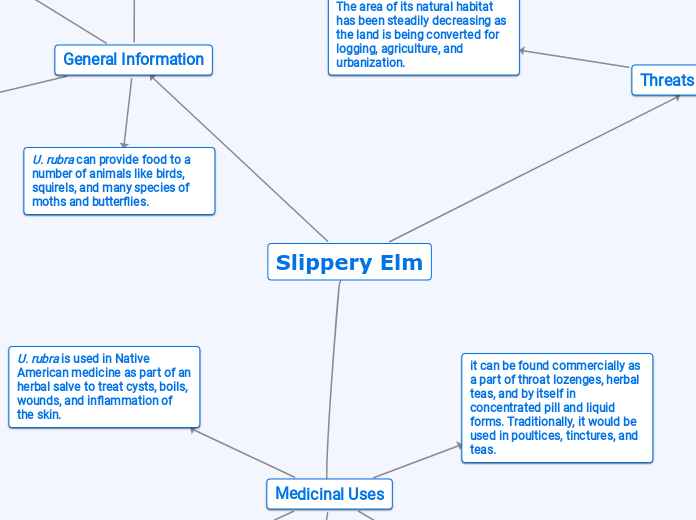Slippery Elm
Threats to the Plant
U. rubra is listed as "special concern" in Rhode Island and has been extirpated in Maine.
U. rubra is vulnerable to a number of insect pests.
Brought to North America by way of imported elms, elm leafminers can now be found in eastern Canada and the northeastern United States. The larvae of this bug eat leaves by going inside them and consuming the inside of the leaf, hence their name. If enough larvae feast on the same leaf, it will wither and die.
The Asian longhorn beetle is an invasive species from China. The female beetle will bore holes in the tree before laying its eggs. When the eggs hatch, the larvae will begin eating the phloem tissue, and as they mature, they will make their way into the tree. creating tunnels. These tunnels weaken the tree and cause death.
Dutch elm disease (DED), a devastating fungal disease that targets species in the Ulmus and Zelkova genera, is one of the biggest threats to the slippery elm as the tree is vulnerable to the disease. Because of DED, the number of mature trees in nature has dwindled significantly.
The spores of this disease are spread mainly by the European elm bark beetle.
The area of its natural habitat has been steadily decreasing as the land is being converted for logging, agriculture, and urbanization.
Medicinal Uses
As research on the tree is limited, its level of safety is questionable. Common side effects include skin irritation and allergic reactions to those that are allergic to elm pollen. In folk medicine, it is consumed by pregnant women to abort the baby, those that are pregnant are advised to not ingest it.
U. rubra is claimed to cure many gastrointestinal tract problems like coughs, sore throat, colic, diarrhea, constipation, hemorrhoids, irritable bowel syndrome, bladder and urinary tract infections, syphilis, herpes, and for expelling tapeworms.
These ailments target your digestive system. The system is responsible for breaking down food and absorbing the nutrients in them.
The digestive system is made up of the mouth, esophagus, stomach, small intestine, large intestine, anus, liver, pancreas, and gallbladder.
Although U. rubra is said to cure and treat these ailments, more scientific research is needed to confirm these claims.
The inner bark of the tree contains mucilage. Mucilage is made up of carbohydrates that form a sticky substance when combined with water. This substance can be used to coat the gastrointestinal tract and mucous membranes.
U. rubra is used in Native American medicine as part of an herbal salve to treat cysts, boils, wounds, and inflammation of the skin.
it can be found commercially as a part of throat lozenges, herbal teas, and by itself in concentrated pill and liquid forms. Traditionally, it would be used in poultices, tinctures, and teas.
General Information
U. rubra can provide food to a number of animals like birds, squirels, and many species of moths and butterflies.
The name 'slippery elm' comes from the slimy liquid produced when chewing on the inner bark.
The tree is also known as red elm because of the reddish colour of its wood.
The plant is a species of elm that can be found
in Eastern North America.
Taxonomy
Kingdom-- Plantae
Division-- Tracheophyta
Class-- Magnoliopsida
Order-- Rosales
Family-- Ulmaceae
Genus-- Ulmus L.
Species-- Ulmus rubra









